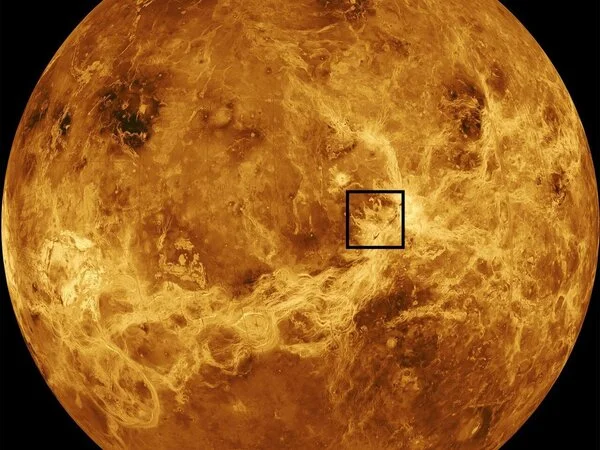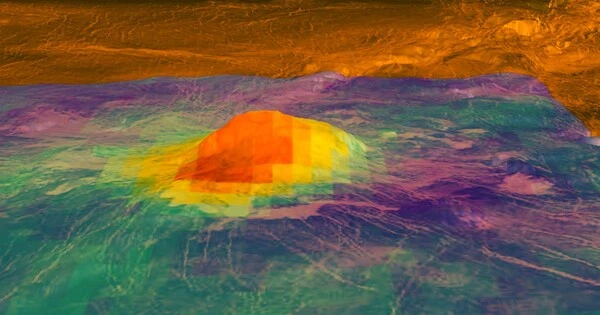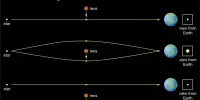There is strong evidence to suggest that Venus is volcanically active, although the activity may not be as frequent or intense as it was in the past. According to a new research paper, Venus appears to have volcanic activity, which provides strong evidence to answer the lingering question of whether Earth’s sister planet currently has eruptions and lava flows. Venus, while similar in size and mass to Earth, differs significantly in that it lacks plate tectonics. The primary sites of volcanic activity are the boundaries of Earth’s moving surface plates.
Robert Herrick, a research professor at the University of Alaska Fairbanks Geophysical Institute, discovered a nearly 1-square-mile volcanic vent in 1991 that changed shape and grew over an eight-month period. On Earth, changes on this scale are associated with volcanic activity, whether through an eruption at the vent or movement of magma beneath the vent, causing the vent walls to collapse and the vent to expand.
The research was published today in the journal Science.
We can now say that Venus is currently volcanically active in the sense that there are at least a few eruptions per year. We can expect the upcoming Venus missions to observe new volcanic flows that have occurred since the Magellan mission ended three decades ago, and we should see some activity occurring while the two upcoming orbital missions are collecting images.
Robert Herrick
Herrick examined images captured by NASA’s Magellan space probe during its first two imaging cycles in the early 1990s. Until recently, comparing digital images to find new lava flows took too long, according to the paper. As a result, few scientists have looked for feature formation in Magellan data.
“The Magellan data has really only been available at full resolution, mosaicked, and easily manipulable by an investigator with a typical personal workstation for the last decade or so,” Herrick said.
The new study concentrated on two of Venus’ largest volcanoes, Ozza and Maat Mons. “Ozza and Maat Mons are comparable in volume to Earth’s largest volcanoes, but they have lower slopes and are thus more spread out,” Herrick explained.
Maat Mons has an expanded vent, indicating volcanic activity. Herrick compared a Magellan image from mid-February 1991 to a mid-October 1991 image and noticed a change to a vent on the north side of the Maat Mons volcano’s domed shield volcano.

The vent had grown from a roughly 1 square mile circular formation to an irregular 1.5 square mile shape. The later image shows that the vent’s walls became shorter, possibly only a few hundred feet tall, and that the vent was nearly full. The researchers hypothesize that a lava lake formed in the vent between the images, though whether the contents were liquid or cooled and solidified is unknown.
The researchers do offer one caveat: the expansion could have been caused by a nonvolcanic, earthquake-triggered collapse of the vent’s walls. However, they point out that vent collapses of this magnitude on Earth’s volcanoes have always been accompanied by nearby volcanic eruptions; magma withdraws from beneath the vent because it is on its way somewhere else.
Venus’s surface is geologically young, especially when compared to all other rocky bodies except Earth and Jupiter’s moon Io, according to Herrick. “However, estimates of how frequently eruptions on Venus might occur have been speculative, ranging from several large eruptions per year to one such eruption every several or even tens of years,” he said.
Herrick contrasts the lack of information about Venusian volcanism with what is known about Jupiter’s moon Io and about Mars. “Io is so active that multiple ongoing eruptions have been imaged every time we’ve observed it,” he said.
On a geological time scale, relatively young lava flows indicate Mars remains volcanically active, Herrick said. “However, nothing has occurred in the 45 years that we have been observing Mars, and most scientists would say that you’d probably need to watch the surface for a few million years to have a reasonable chance of seeing a new lava flow,” he said.
Herrick’s research adds Venus to the small pool of volcanically active bodies in our solar system.
“We can now say that Venus is currently volcanically active in the sense that there are at least a few eruptions per year,” he said. “We can expect the upcoming Venus missions to observe new volcanic flows that have occurred since the Magellan mission ended three decades ago, and we should see some activity occurring while the two upcoming orbital missions are collecting images.”
















